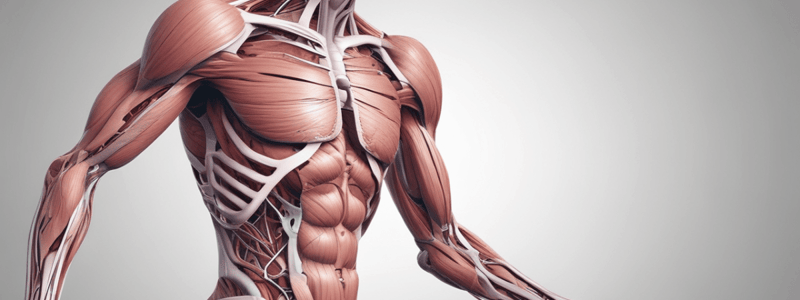Podcast
Questions and Answers
What is the main characteristic of skeletal muscle cells under microscopic observation?
What is the main characteristic of skeletal muscle cells under microscopic observation?
- Uninucleated
- Striated (correct)
- Non-striated
- Multinucleated
What is the function of myofilaments in skeletal muscle?
What is the function of myofilaments in skeletal muscle?
- They are involved in muscle relaxation
- They regulate muscle contraction
- They provide structural support
- They are the actual contractile elements (correct)
What type of muscle is found in the wall of the heart?
What type of muscle is found in the wall of the heart?
- Skeletal muscle
- Intestinal muscle
- Smooth muscle
- Cardiac muscle (correct)
What is the smallest functional unit of myofibril?
What is the smallest functional unit of myofibril?
What is the type of protein that myosin belongs to?
What is the type of protein that myosin belongs to?
What is the function of tropomyosin and troponin?
What is the function of tropomyosin and troponin?
What is the outermost layer of a muscle fiber called?
What is the outermost layer of a muscle fiber called?
What type of muscle is found in the intestine and stomach?
What type of muscle is found in the intestine and stomach?
What is the structure of the tail of the myosin molecule?
What is the structure of the tail of the myosin molecule?
What is the function of the amino terminal globular ends of myosin?
What is the function of the amino terminal globular ends of myosin?
What is the role of actin in muscle contraction?
What is the role of actin in muscle contraction?
What is the function of tropomyosin in muscle contraction?
What is the function of tropomyosin in muscle contraction?
What is the composition of the myosin molecule?
What is the composition of the myosin molecule?
What is the function of the myosin head?
What is the function of the myosin head?
What is the role of troponin in muscle contraction?
What is the role of troponin in muscle contraction?
What is the composition of the tropomyosin molecule?
What is the composition of the tropomyosin molecule?
Flashcards are hidden until you start studying
Study Notes
Classification of Muscles
- There are two main types of muscles: striated muscles and smooth muscles
- Striated muscles are further classified into skeletal muscle (attached to bone) and cardiac muscle (found in the heart)
- Smooth muscle cells appear non-striated and are found in the intestine, stomach, and lung
Structure of Skeletal Muscle
- Muscle fibers are multinucleated and surrounded by the sarcolemma (plasma membrane)
- Each muscle fiber is composed of many myofibrils
- Myofibrils are made up of bundles of myofilaments
- Myofilaments consist of thick filaments (myosin) and thin filaments (actin, tropomyosin, and troponin)
- Myofilaments are the actual contractile elements of striated muscle
- Sarcomere represents the smallest functional unit of myofibril
Protein Composition of Muscle Fibers
- Muscle contains two main types of proteins: contractile proteins and regulatory proteins
- Contractile proteins include myosin and actin
- Regulatory proteins include tropomyosin and troponin
Myosin
- Each myosin molecule is composed of 6 polypeptide chains (2 heavy chains and 4 light chains)
- The heavy chains twist around each other to form a double helix (tail of the myosin molecule)
- The amino terminal end of each heavy chain folds into a globular structure (myosin head)
- Myosin exhibits ATPase activity, which hydrolyzes ATP to ADP + Pi and provides free energy for muscle contraction
- Myosin interacts with actin to generate the force that moves the thick and thin filaments past each other
Actin
- Actin is the major constituent of thin filament of muscle fiber
- Actin is a polymer of globular-shaped subunit called G-actin
- G-actin polymerizes into a fibrous or filamentous form called F-actin in the presence of Mg2+ ions
- Each G-actin molecule has a binding site for myosin
- Actin plays a major role in muscle contraction in association with myosin
Regulatory Proteins
Tropomyosin
- Tropomyosin is a constituent of thin filaments of the muscle
- Tropomyosin is made up of two polypeptide chains wrapped spirally around the sides of the F-actin helix
- In the resting state, tropomyosin molecules lie on top of the active sites of the actin strands, preventing attraction between actin and myosin filaments to cause contraction
- Tropomyosin regulates the attachment of actin and myosin during contraction
Troponin
- Troponin is a constituent of thin filaments of the muscle
- Troponin is involved in the contraction process by regulating the attachment of actin and myosin
Studying That Suits You
Use AI to generate personalized quizzes and flashcards to suit your learning preferences.




